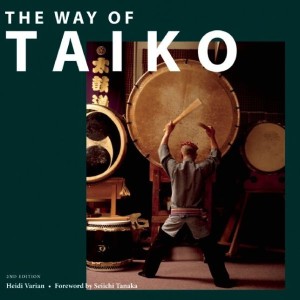JQ Magazine – Book Review: ‘The Way of Taiko’

“Those who want to learn more about taiko, whether they are novices in Japanese drumming or have been playing for several years, will be amazed by the rich history and culture of the genre.” (Stone Bridge Press)
By Rashaad Jorden (Yamagata-ken, 2008-10) for JQ magazine. A former head of the JETAA Philadelphia Sub-Chapter, Rashaad currently studies responsible tourism management at Leeds Metropolitan University. For more on his life in the UK and enthusiasm for taiko drumming, visit his blog at www.gettingpounded.wordpress.com.
Many JETs—myself included—have been drawn to taiko because we love the sound emanating from the drums and want to partake in something traditionally Japanese. But what do we really know about taiko?
For those looking to expand their knowledge of Japanese drumming, Heidi Varian’s The Way of Taiko (now available in a new edition from Stone Bridge Press) is a great way to go. Varian, a member of the San Francisco Taiko Dojo, introduces readers to the history and contemporary culture of the music that is a symbol of Japan to many.
Varian calls taiko the “heartbeat of Japan,” and that’s appropriate because the drum was a method of gathering townspeople or letting them know about any impending danger, in addition to being used to celebrate festivals. Like seemingly everything that’s considered an integral part of Japan, taiko has an enormously long history clouded in mystery (it actually may not have originated in Japan), but Varian explores it.
She not only examines taiko’s beginning and its importance in ancient Japan, but how taiko appeared in traditional Japanese theatrical forms like noh and kabuki. She also writes about how taiko gained a foothold in the United States—the first documented taiko drum appeared in San Francisco in 1910—and its pioneers (such as Seiichi Tanaka and Kenny Endo) on this side of the Pacific. Varian also doesn’t also live in the past when talking about taiko, as she raises important issues about its future.
The Way of Taiko also shines when its describes in detail the visual aspects of taiko, such as the instruments, drumsticks, formal wear and frequent mannerisms displayed during a performance, and their significance in Japanese drumming (Varian writes that “vocalizations are an important part of any taiko performance, offering invocations, encouragement, timing and directions to others”).
Although Varian is an American of Icelandic descent, she does sound very Japanese when she writes about the emotional and physical aspects of taiko—like playing from the heart, learning how to breathe and maintain correct posture—and how to use them to your benefit. Varian writes that “each beat should be played with full spirit, whether quiet or powerful, and have the full commitment of the player.” It seems like she’s writing a “how-to” guide for those trying to get the most out of taiko (the book even includes a glossary of commonly used terms).
While it was fascinating to read about how taiko has grown in the United States, others might wonder if taiko has rivaled other forms of Japanese culture such as anime and manga in gaining worldwide popularity. Even a word or two about taiko in places other than the United States and Japan (such as mentioning noted taiko ensembles) would have enhanced the book.
However, those who want to learn more about taiko, whether they are novices in Japanese drumming or have been playing for several years, will be amazed by the rich history and culture of the genre. After reading The Way of Taiko, they will develop a deeper appreciation for the “heartbeat of Japan.”
The Way of Taiko is available Oct. 1. For more JQ magazine book reviews, click here.


Comments are closed.